warning light BUICK RANDEZVOUS 2007 Owner's Guide
[x] Cancel search | Manufacturer: BUICK, Model Year: 2007, Model line: RANDEZVOUS, Model: BUICK RANDEZVOUS 2007Pages: 528, PDF Size: 2.99 MB
Page 311 of 528
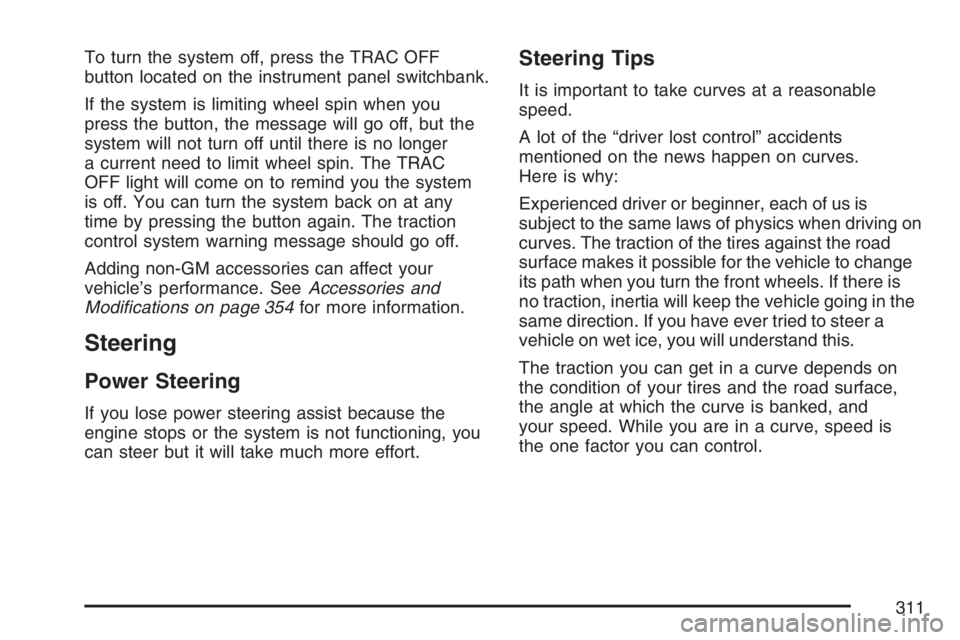
To turn the system off, press the TRAC OFF
button located on the instrument panel switchbank.
If the system is limiting wheel spin when you
press the button, the message will go off, but the
system will not turn off until there is no longer
a current need to limit wheel spin. The TRAC
OFF light will come on to remind you the system
is off. You can turn the system back on at any
time by pressing the button again. The traction
control system warning message should go off.
Adding non-GM accessories can affect your
vehicle’s performance. SeeAccessories and
Modi�cations on page 354for more information.
Steering
Power Steering
If you lose power steering assist because the
engine stops or the system is not functioning, you
can steer but it will take much more effort.
Steering Tips
It is important to take curves at a reasonable
speed.
A lot of the “driver lost control” accidents
mentioned on the news happen on curves.
Here is why:
Experienced driver or beginner, each of us is
subject to the same laws of physics when driving on
curves. The traction of the tires against the road
surface makes it possible for the vehicle to change
its path when you turn the front wheels. If there is
no traction, inertia will keep the vehicle going in the
same direction. If you have ever tried to steer a
vehicle on wet ice, you will understand this.
The traction you can get in a curve depends on
the condition of your tires and the road surface,
the angle at which the curve is banked, and
your speed. While you are in a curve, speed is
the one factor you can control.
311
Page 320 of 528

Driving Through Deep Standing Water
Notice:If you drive too quickly through
deep puddles or standing water, water can
come in through your engine’s air intake and
badly damage your engine. Never drive through
water that is slightly lower than the underbody
of your vehicle. If you cannot avoid deep
puddles or standing water, drive through them
very slowly.
Driving Through Flowing Water
{CAUTION:
Flowing or rushing water creates strong
forces. If you try to drive through �owing
water, as you might at a low water
crossing, your vehicle can be carried away.
CAUTION: (Continued)
CAUTION: (Continued)
As little as six inches of �owing water can
carry away a smaller vehicle. If this
happens, you and other vehicle occupants
could drown. Do not ignore police
warning signs, and otherwise be very
cautious about trying to drive through
�owing water.
Some Other Rainy Weather Tips
Besides slowing down, allow some extra
following distance. And be especially careful
when you pass another vehicle. Allow yourself
more clear room ahead, and be prepared to
have your view restricted by road spray.
Have good tires with proper tread depth. See
Tires on page 406.
320
Page 321 of 528
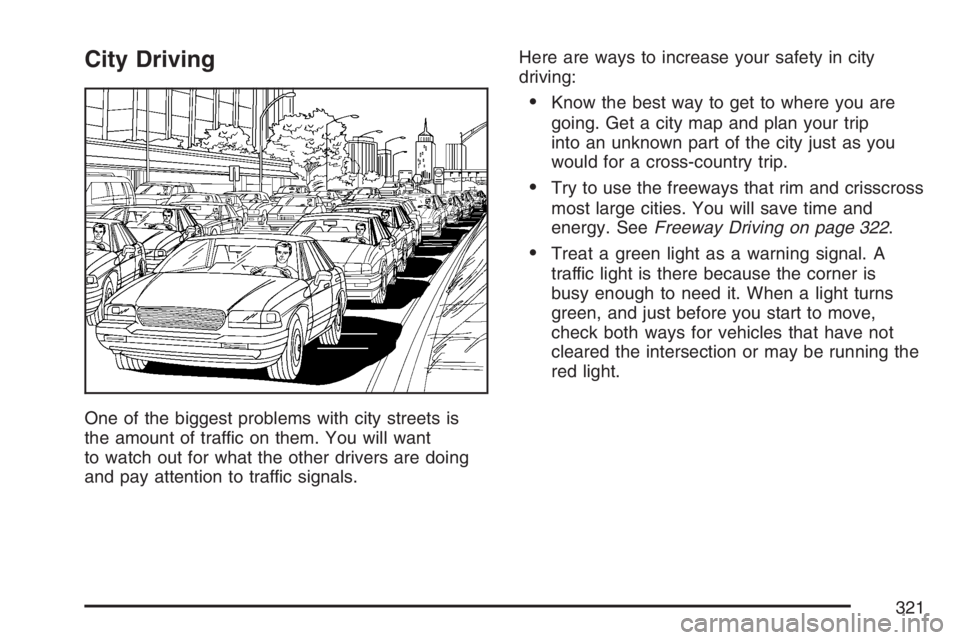
City Driving
One of the biggest problems with city streets is
the amount of traffic on them. You will want
to watch out for what the other drivers are doing
and pay attention to traffic signals.Here are ways to increase your safety in city
driving:
Know the best way to get to where you are
going. Get a city map and plan your trip
into an unknown part of the city just as you
would for a cross-country trip.
Try to use the freeways that rim and crisscross
most large cities. You will save time and
energy. SeeFreeway Driving on page 322.
Treat a green light as a warning signal. A
traffic light is there because the corner is
busy enough to need it. When a light turns
green, and just before you start to move,
check both ways for vehicles that have not
cleared the intersection or may be running the
red light.
321
Page 327 of 528
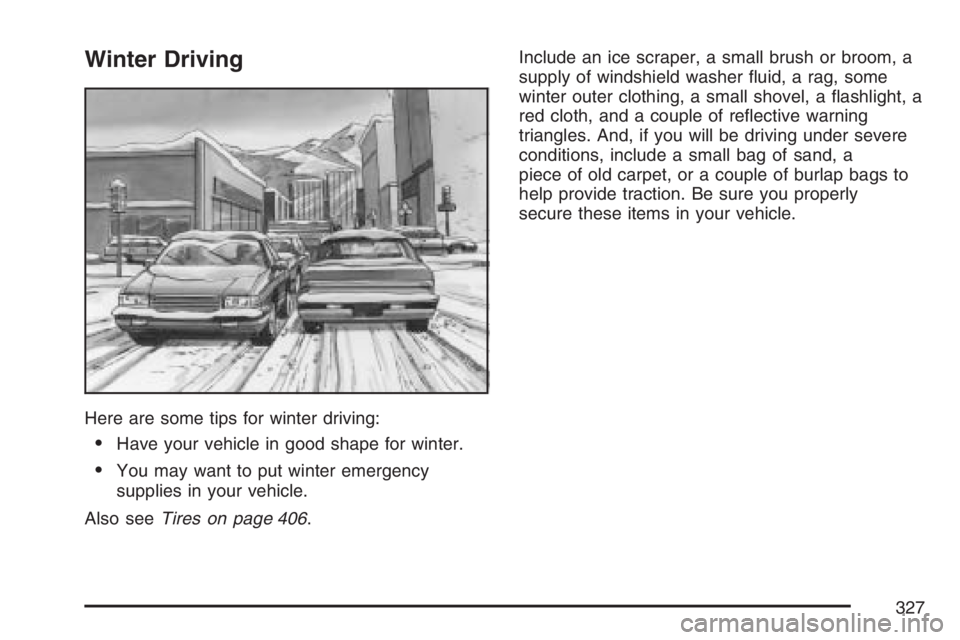
Winter Driving
Here are some tips for winter driving:
Have your vehicle in good shape for winter.
You may want to put winter emergency
supplies in your vehicle.
Also seeTires on page 406.Include an ice scraper, a small brush or broom, a
supply of windshield washer �uid, a rag, some
winter outer clothing, a small shovel, a �ashlight, a
red cloth, and a couple of re�ective warning
triangles. And, if you will be driving under severe
conditions, include a small bag of sand, a
piece of old carpet, or a couple of burlap bags to
help provide traction. Be sure you properly
secure these items in your vehicle.
327
Page 390 of 528
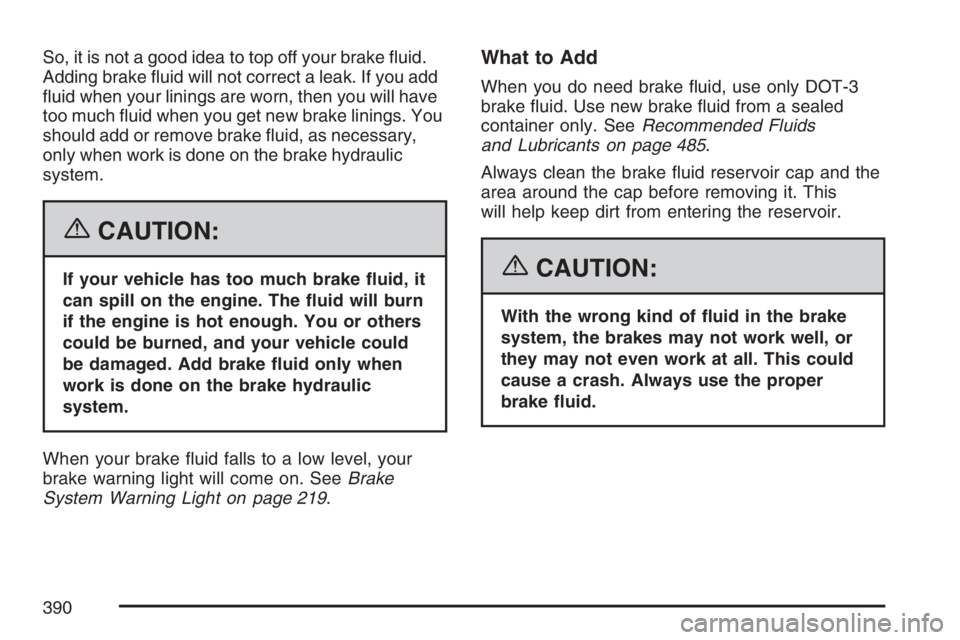
So, it is not a good idea to top off your brake �uid.
Adding brake �uid will not correct a leak. If you add
�uid when your linings are worn, then you will have
too much �uid when you get new brake linings. You
should add or remove brake �uid, as necessary,
only when work is done on the brake hydraulic
system.
{CAUTION:
If your vehicle has too much brake �uid, it
can spill on the engine. The �uid will burn
if the engine is hot enough. You or others
could be burned, and your vehicle could
be damaged. Add brake �uid only when
work is done on the brake hydraulic
system.
When your brake �uid falls to a low level, your
brake warning light will come on. SeeBrake
System Warning Light on page 219.
What to Add
When you do need brake �uid, use only DOT-3
brake �uid. Use new brake �uid from a sealed
container only. SeeRecommended Fluids
and Lubricants on page 485.
Always clean the brake �uid reservoir cap and the
area around the cap before removing it. This
will help keep dirt from entering the reservoir.
{CAUTION:
With the wrong kind of �uid in the brake
system, the brakes may not work well, or
they may not even work at all. This could
cause a crash. Always use the proper
brake �uid.
390
Page 391 of 528

Notice:
Using the wrong �uid can badly damage
brake system parts. For example, just a
few drops of mineral-based oil, such
as engine oil, in the brake system can
damage brake system parts so badly that
they will have to be replaced. Do not
let someone put in the wrong kind of �uid.
If you spill brake �uid on your vehicle’s
painted surfaces, the paint �nish can
be damaged. Be careful not to spill brake
�uid on your vehicle. If you do, wash it
off immediately. SeeWashing Your Vehicle
on page 455.
Brake Wear
Your vehicle has four-wheel disc brakes.
Disc brake pads have built-in wear indicators that
make a high-pitched warning sound when the brake
pads are worn and new pads are needed. The
sound may come and go or be heard all the time
your vehicle is moving, except when you are
pushing on the brake pedal �rmly.
{CAUTION:
The brake wear warning sound means that
soon the brakes will not work well. That
could lead to an accident. When you hear
the brake wear warning sound, have your
vehicle serviced.
Notice:Continuing to drive with worn-out
brake pads could result in costly brake repair.
Some driving conditions or climates may cause
a brake squeal when the brakes are �rst applied or
lightly applied. This does not mean something is
wrong with your brakes.
391
Page 415 of 528
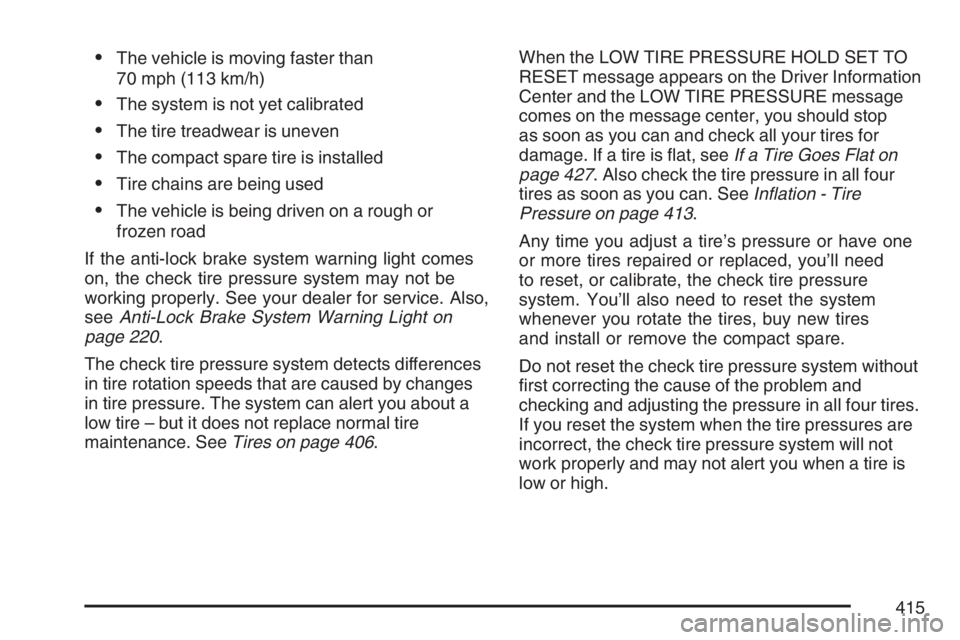
The vehicle is moving faster than
70 mph (113 km/h)
The system is not yet calibrated
The tire treadwear is uneven
The compact spare tire is installed
Tire chains are being used
The vehicle is being driven on a rough or
frozen road
If the anti-lock brake system warning light comes
on, the check tire pressure system may not be
working properly. See your dealer for service. Also,
seeAnti-Lock Brake System Warning Light on
page 220.
The check tire pressure system detects differences
in tire rotation speeds that are caused by changes
in tire pressure. The system can alert you about a
low tire – but it does not replace normal tire
maintenance. SeeTires on page 406.When the LOW TIRE PRESSURE HOLD SET TO
RESET message appears on the Driver Information
Center and the LOW TIRE PRESSURE message
comes on the message center, you should stop
as soon as you can and check all your tires for
damage. If a tire is �at, seeIf a Tire Goes Flat on
page 427. Also check the tire pressure in all four
tires as soon as you can. SeeIn�ation - Tire
Pressure on page 413.
Any time you adjust a tire’s pressure or have one
or more tires repaired or replaced, you’ll need
to reset, or calibrate, the check tire pressure
system. You’ll also need to reset the system
whenever you rotate the tires, buy new tires
and install or remove the compact spare.
Do not reset the check tire pressure system without
�rst correcting the cause of the problem and
checking and adjusting the pressure in all four tires.
If you reset the system when the tire pressures are
incorrect, the check tire pressure system will not
work properly and may not alert you when a tire is
low or high.
415
Page 421 of 528
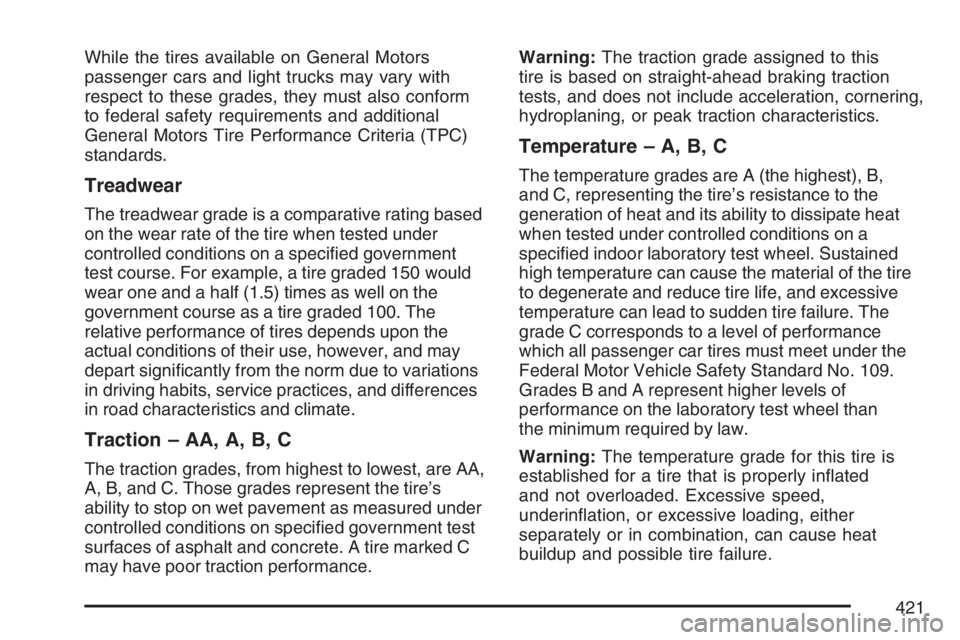
While the tires available on General Motors
passenger cars and light trucks may vary with
respect to these grades, they must also conform
to federal safety requirements and additional
General Motors Tire Performance Criteria (TPC)
standards.
Treadwear
The treadwear grade is a comparative rating based
on the wear rate of the tire when tested under
controlled conditions on a speci�ed government
test course. For example, a tire graded 150 would
wear one and a half (1.5) times as well on the
government course as a tire graded 100. The
relative performance of tires depends upon the
actual conditions of their use, however, and may
depart signi�cantly from the norm due to variations
in driving habits, service practices, and differences
in road characteristics and climate.
Traction – AA, A, B, C
The traction grades, from highest to lowest, are AA,
A, B, and C. Those grades represent the tire’s
ability to stop on wet pavement as measured under
controlled conditions on speci�ed government test
surfaces of asphalt and concrete. A tire marked C
may have poor traction performance.Warning:The traction grade assigned to this
tire is based on straight-ahead braking traction
tests, and does not include acceleration, cornering,
hydroplaning, or peak traction characteristics.
Temperature – A, B, C
The temperature grades are A (the highest), B,
and C, representing the tire’s resistance to the
generation of heat and its ability to dissipate heat
when tested under controlled conditions on a
speci�ed indoor laboratory test wheel. Sustained
high temperature can cause the material of the tire
to degenerate and reduce tire life, and excessive
temperature can lead to sudden tire failure. The
grade C corresponds to a level of performance
which all passenger car tires must meet under the
Federal Motor Vehicle Safety Standard No. 109.
Grades B and A represent higher levels of
performance on the laboratory test wheel than
the minimum required by law.
Warning:The temperature grade for this tire is
established for a tire that is properly in�ated
and not overloaded. Excessive speed,
underin�ation, or excessive loading, either
separately or in combination, can cause heat
buildup and possible tire failure.
421
Page 513 of 528

A
Accessories and Modi�cations..................... 354
Accessory In�ator........................................ 425
Accessory Power Outlet(s).......................... 199
Adding Equipment to Your Airbag-Equipped
Vehicle..................................................... 103
Additives, Fuel............................................ 357
Add-On Electrical Equipment....................... 462
Air Cleaner/Filter, Engine............................. 370
Air Conditioning.........................200, 203, 206
Airbag
Passenger Status Indicator....................... 217
Readiness Light....................................... 215
Airbag Sensing and Diagnostic
Module (SDM).......................................... 503
Airbag System............................................... 88
Adding Equipment to Your
Airbag-Equipped Vehicle....................... 103
How Does an Airbag Restrain?.................. 96
Passenger Sensing System....................... 98
Servicing Your Airbag-Equipped Vehicle.... 102
What Makes an Airbag In�ate?.................. 95
What Will You See After an Airbag
In�ates?................................................. 96
When Should an Airbag In�ate?................. 93
Where Are the Airbags?............................. 91Airbag System (cont.)
Antenna, Fixed Mast................................... 299
Antenna, XM™ Satellite Radio Antenna
System.................................................... 299
Anti-Lock Brake System (ABS).................... 307
Anti-Lock Brake, System Warning Light....... 220
Appearance Care
Aluminum or Chrome-Plated Wheels........ 457
Care of Safety Belts................................ 455
Chemical Paint Spotting........................... 459
Cleaning Exterior Lamps/Lenses.............. 456
Cleaning the Inside of Your Vehicle.......... 451
Fabric/Carpet........................................... 453
Finish Care.............................................. 456
Finish Damage......................................... 459
Instrument Panel, Vinyl, and Other
Plastic Surfaces.................................... 454
Leather.................................................... 454
Sheet Metal Damage............................... 458
Tires........................................................ 458
Underbody Maintenance........................... 459
Vehicle Care/Appearance Materials.......... 460
Washing Your Vehicle .............................. 455
Weatherstrips........................................... 455
Windshield, Backglass, and
Wiper Blades........................................ 457
513
Page 514 of 528

Ashtray(s).................................................... 200
Audio System(s).......................................... 250
Audio Steering Wheel Controls................. 296
Care of Your CD and DVD Player............ 298
Care of Your CDs and DVDs................... 298
Fixed Mast Antenna................................. 299
Navigation/Radio System, see
Navigation Manual................................ 277
Radio with CD......................................... 252
Radio with Six-Disc CD............................ 262
Rear Seat Audio (RSA)............................ 293
Setting the Time...................................... 252
Theft-Deterrent Feature............................ 296
Understanding Radio Reception............... 297
XM™ Satellite Radio Antenna System...... 299
Automatic Headlamp System....................... 187
Automatic Transaxle
Fluid........................................................ 372
Operation................................................. 132
B
Battery........................................................ 393
Run-Down Protection............................... 192
Before Leaving on a Long Trip.................... 323
Bench Seat, Split.......................................... 15Brake
Anti-Lock Brake System (ABS)................. 307
Emergencies............................................ 309
Low Fluid Warning Message.................... 232
Parking.................................................... 135
System Warning Light.............................. 219
Brakes........................................................ 389
Braking....................................................... 306
Braking in Emergencies............................... 309
Break-In, New Vehicle................................. 127
Bulb Replacement....................................... 399
Halogen Bulbs......................................... 399
Headlamps, Front Turn Signal,
Sidemarker, and Parking Lamps........... 399
Replacement Bulbs.................................. 404
Taillamps and Back-Up Lamps................. 402
Taillamps, Turn Signal, and Stoplamps..... 401
Buying New Tires........................................ 418
C
Calibration................................................... 238
California Fuel............................................. 357
California Proposition 65 Warning................ 355
Canadian Owners........................................... 3
Capacities and Speci�cations...................... 469
Captain Chairs, Rear..................................... 21
514